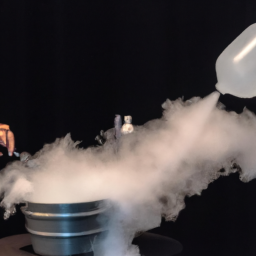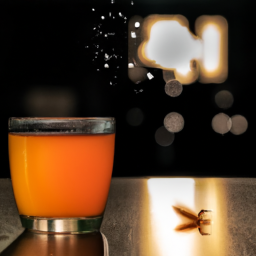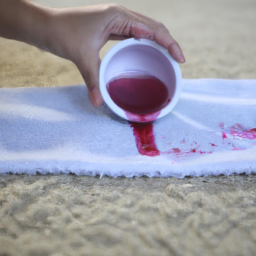Have you ever been to a Halloween party or show and seen a thick, eerie fog covering the area? This fog is created using fog juice, a special liquid that is heated and released into the air by a fog machine.
Making your own fog juice may seem like a daunting task, but with the right ingredients and equipment, it can be a fun and rewarding DIY project.
In this article, I will guide you through the process of making fog juice from scratch. We will start by exploring the science behind fog and the different types of fog juice available.
Then, we will gather the necessary ingredients and equipment before mixing the juice and testing it out in a fog machine.
I will also provide tips for adjusting the fog output and troubleshooting common issues.
So, put on your lab coat and let’s get started!
Key Takeaways
- Fog juice is made from a combination of glycol, distilled water, and glycerin, with optional additives for enhanced effects.
- Proper equipment and mixing techniques are crucial for making high-quality fog juice.
- Regular maintenance and cleaning of fog machines is important for optimal performance and safety.
- Adjusting the density and duration of fog output can be achieved by adjusting the amount of fog juice used, temperature, and timer settings.
Understanding the Science Behind Fog Juice
You’re probably wondering why fog juice creates such a thick and eerie mist, but let me tell you, it’s all thanks to the unique chemical properties of glycol and water mixing together.
When these two substances are heated, a chemical reaction occurs, causing the glycol to break down into tiny particles. These particles then combine with the water vapor and create a dense fog that sticks to surfaces and fills the air.
The particle size of the glycol is also a key factor in creating the perfect fog. By controlling the size of the particles, we can adjust the density and thickness of the fog.
This is achieved by heating the mixture to a specific temperature and pressure, which causes the glycol particles to vaporize and mix with the water vapor.
Understanding the science behind fog juice is crucial in creating a high-quality fog effect that will enhance any event or performance. Now, let’s move on to gathering the necessary ingredients for making your own fog juice.
Gathering the Necessary Ingredients
Before we can start making our own fog juice, we need to gather the necessary ingredients. The key components we’ll need are propylene glycol, distilled water, and glycerin.
These ingredients are essential for creating the fog effect. But we can also add optional additives to enhance the performance of our fog juice.
Propylene Glycol
One key ingredient in fog juice is propylene glycol, which helps create the thick, misty effect that makes for a great spooky atmosphere. Propylene glycol is a colorless, odorless liquid that is commonly used in the food, cosmetic, and pharmaceutical industries. It has a low toxicity and is considered safe for human consumption in small amounts. However, it is important to take safety precautions when handling propylene glycol in its concentrated form.
Here is a table outlining some important uses and safety precautions when handling propylene glycol:
| Uses of Propylene Glycol | Safety Precautions |
|---|---|
| Antifreeze | Use gloves when handling |
| Food additive | Avoid inhalation |
| Humectant in cosmetics | Store in a cool, dry place |
Now that we know more about propylene glycol, let’s move on to the next ingredient: distilled water.
Distilled Water
After adding propylene glycol, the next ingredient in creating the perfect spooky mist is distilled water. It is commonly used in many household products. Distilled water is water that has undergone a purification process to remove impurities such as minerals and other contaminants.
The process of distillation involves boiling water and then condensing the vapor back into liquid form. This leaves behind any impurities that may have been present in the original water source. Distilled water is preferred over tap water when making fog juice because it is free of impurities that could potentially clog up the fog machine.
Additionally, using distilled water reduces the environmental impact as it does not contribute to the pollution caused by the disposal of contaminated water. After adding distilled water, the final ingredient in creating fog juice is glycerin. This serves as a thickening agent to create a longer lasting fog effect.
Glycerin
To create a more long-lasting and dense mist, you’ll want to add glycerin as a thickening agent to your fog mixture. Glycerin is a clear, odorless liquid that is commonly used in skincare because of its moisturizing properties. When added to fog juice, it helps to create a thicker mist that will linger in the air for longer periods of time.
There are different types of glycerin products that you can use in your fog juice. Vegetable glycerin is a popular choice because it’s derived from plant oils and is considered more eco-friendly. Pharmaceutical-grade glycerin is another option, which is highly purified and free of impurities. It’s important to note that not all glycerin products are the same, so be sure to choose one that’s appropriate for your fog juice recipe.
Moving on to the subsequent section about optional additives, there are other ingredients that you can incorporate into your fog juice for added effects.
Optional Additives
You can enhance the effects of your fog mixture with optional additives like UV reactive dye. This can make your fog glow under black lights and add a unique touch to your Halloween party. The benefits of additives are that they can help to create a more realistic and dense fog, and also add visual effects that can enhance the overall atmosphere of your event.
Choosing the right additives is important, as some may not be compatible with your fog machine or may produce harmful fumes. In addition to UV reactive dye, there are other additives you can consider, such as fog scent, which can give your fog a pleasant aroma, or dry ice, which can create a low-lying fog effect.
However, it’s crucial to follow the manufacturer’s instructions when using any additives and to ensure that they’re safe to use with your fog machine. With the right combination of additives, you can create a unique and memorable fog experience for your guests. Now, let’s move on to the equipment needed for making fog juice.
Equipment Needed for Making Fog Juice
First, I gather the necessary equipment for making fog juice. I need a heat-resistant container to hold the mixture while it heats up. There are different types of containers that I can use, such as a glass beaker or a stainless steel pot.
I also need measuring tools, like a graduated cylinder and a digital scale, to ensure accurate proportions of the ingredients. The ingredients I need are distilled water, glycerin, and propylene glycol.
Once I have all the equipment and ingredients, it’s time to start mixing them together. But before I get into that, it’s important to make sure that everything is clean and free of any debris.
Now that I have everything set up, I can start mixing the ingredients together to create the perfect fog juice.
Mixing the Ingredients
Now that we have all the necessary equipment, it’s time to mix the ingredients for our fog juice. Mixing the ingredients is a crucial step in making fog juice, as the right mixture will result in a good quality fog. There are different mixing techniques that you can use depending on the recipe you are following. However, it’s important to always follow safety precautions when handling chemicals.
To ensure that we have a consistent mixture, we can use a 2 column and 5 row table to keep track of the measurements of each ingredient. This will help us avoid any mistakes in the mixing process that could potentially ruin the quality of our fog juice. When mixing, start by adding the distilled water to the mixing container, followed by the glycerin. Glycerin is a thick, syrupy liquid that will give the fog density and hang time. Next, add the propylene glycol, which will help keep the fog juice from clogging the fog machine. Finally, add the distilled white vinegar, which is responsible for creating the fog effect.
It’s important to note that safety precautions must be taken when mixing the ingredients. Wear protective gear such as gloves and goggles, as some of the chemicals used can be harmful if they come into contact with the skin or eyes. Once all the ingredients have been added, stir the mixture thoroughly until everything is well combined. Now that we have our fog juice mixture, we can move on to preparing the fog machine for use.
Preparing the Fog Machine
Before getting the fog machine ready, it’s important to ensure that it’s in good condition and has been regularly maintained. Here are some cleaning tips and maintenance procedures to follow:
- Clean the exterior of the machine with a damp cloth to remove any dust or debris.
- Open the machine and check the heating element for any signs of damage or wear.
- Clean the fluid tank and replace any old or contaminated fog juice.
- Check the pump and tubing for any clogs or leaks.
By following these steps, you can ensure that your fog machine is in good working order and will produce the desired amount of fog. Once you’ve completed these tasks, you can move on to testing the fog machine to ensure that it’s working properly.
Testing the Fog Machine
Once you’ve completed the maintenance steps, it’s time to test your fog machine. Testing your fog machine is crucial to ensure it is in optimal condition and ready to give you the desired fog output. Here are some safety precautions to keep in mind before testing your fog machine:
| Safety Precautions | Description |
|---|---|
| Wear gloves | To avoid any burns or injuries from hot machine parts. |
| Use distilled water | Regular water can cause mineral buildup and damage the machine. |
| Test in well-ventilated area | Fog machines can cause respiratory irritation if used in enclosed spaces. |
| Keep away from flammable materials | Fog machines can pose a fire hazard, so keep them away from flammable objects. |
| Follow manufacturer’s instructions | Different fog machines have different optimal settings, so it’s important to follow the instructions to ensure proper use. |
Once you’ve followed the safety precautions, it’s time to test the fog machine. Turn it on and wait for a few minutes for it to heat up. Check the fog output and adjust the settings if necessary. It’s important to find the optimal settings for your fog machine to ensure the desired fog output. Once you’ve found the optimal settings, you’re ready to adjust the fog output.
Adjusting the Fog Output
Now that we’ve got our fog machine set up and ready to go, let’s talk about how we can adjust the output to get the perfect effect.
First, we can control the density of the fog by adjusting the amount of fog juice that’s released. This can be done using the machine’s control panel or remote.
Second, adjusting the duration of the fog output can create different effects depending on the desired mood or atmosphere.
By tweaking these two factors, we can achieve the ideal fog output for any occasion.
Controlling the Density
Surprisingly, adding more water to the fog juice mixture actually decreases the density, not increases it. Instead, controlling the density of the fog output requires adjusting the amount of glycol and/or glycerin in the mixture. Here are three steps to help you control the density of your fog output:
-
Choosing the right container: The container you use to mix your fog juice can affect the density of your fog output. Using a container with a narrow opening can help you control the amount of glycol and/or glycerin you add to your mixture. This can help you achieve a more precise density for your fog output.
-
Adjusting the temperature: The temperature of your fog juice mixture can also affect the density of your fog output. If your mixture is too cold, the fog may be too dense. If it’s too warm, the fog may be too thin. It’s important to experiment with the temperature of your fog juice mixture to find the right balance for your desired density.
-
Mixing the ingredients thoroughly: Once you’ve chosen the right container and adjusted the temperature, it’s important to mix the ingredients thoroughly. This will ensure that the glycol and/or glycerin are evenly distributed throughout the mixture, which will help you achieve a consistent density for your fog output.
Controlling the density of your fog output is just one aspect of achieving the perfect fog effect. The next step is to adjust the duration of your fog output to create the desired effect.
Adjusting the Duration
To achieve the desired effect, you’ll need to adjust how long the fog output lasts by tweaking the timer settings on your fog machine. Fine tuning the duration of the fog output is essential to create the perfect atmosphere for your event.
It’s important to note that some fog machines have timer settings that can be adjusted in increments of seconds, while others can be set for minutes. Experiment with different settings until you find the duration that best suits your needs.
Maximizing efficiency is also crucial when adjusting the duration of the fog output. You don’t want to waste valuable fog juice by having it continuously output for too long. It’s best to start with shorter durations and gradually increase the output time until you find the perfect balance between the desired effect and the efficiency of your fog machine.
Once you have fine-tuned the duration, you can move on to storing the fog juice properly to ensure it lasts for your next event.
Storing the Fog Juice
Properly storing fog juice is crucial to maintaining its quality and effectiveness. Fog juice storage tips include keeping it in a cool, dry place away from direct sunlight. It’s also important to use a proper container for fog juice, such as a sealed plastic bottle or a jug with a tight-fitting lid. Avoid storing fog juice in metal containers, as they can react with the juice and affect its quality.
Additionally, it’s important to label the container with the date of purchase and the date it was opened. Most fog juice has a shelf life of about 1-2 years, but this can vary depending on the brand and quality of the juice.
By following these storage tips, you can ensure that your fog juice lasts as long as possible and remains effective for your fog machine.
Now, let’s move on to troubleshooting common issues that may arise when using fog machines.
Troubleshooting Common Issues
If you’re experiencing issues with your fog machine, don’t worry – troubleshooting common problems is easier than you think. Here are some tips to help you identify the causes and fix the issues:
-
Fog machine not producing fog:
-
Check the fluid level and make sure it isn’t empty.
-
Clean the nozzle and check for clogs or blockages.
-
Check the heating element and make sure it’s functioning properly.
-
Fog machine producing too much or too little fog:
-
Adjust the output control knob to regulate the amount of fog produced.
-
Check the fluid density and make sure it’s properly mixed.
-
Use a different type of fluid if needed to achieve the desired effect.
-
Fog machine overheating or shutting off:
-
Make sure the machine isn’t being used for an extended period of time without a break.
-
Check the power cord and make sure it isn’t damaged or frayed.
-
Clean the internal components and make sure they aren’t blocked or obstructed.
By following these tips, you should be able to troubleshoot and fix any common issues with your fog machine. Remember to always follow the manufacturer’s instructions and safety guidelines when using and maintaining your fog machine.
Frequently Asked Questions
How long does fog juice last once it’s been mixed?
Oh, you want to know how long fog juice lasts once it’s mixed? Well, aren’t you just a ray of sunshine. Storage options are key to extending shelf life. Keep it in a cool, dry place and it can last for months without going bad.
Can you use any type of water to make fog juice?
Filtered or distilled water is recommended for making fog juice as impurities can clog the machine’s nozzle and reduce the fog output. Using tap water may also contain minerals that can damage the machine over time.
Why is the fog machine not producing any fog?
Did you know that 90% of fog machine issues are caused by improper maintenance? To troubleshoot, check the fluid level, nozzle, and pump. Common causes include clogged filters and low fluid levels.
Can you add scents or colors to the fog juice?
Yes, it’s possible to add scents and colors to the fog juice. Scented fog can be achieved by adding a small amount of fragrance oil, while colored fog requires the use of food coloring or specialized dyes. However, always follow manufacturer guidelines to avoid damaging the fog machine.
Is it safe to breathe in the fog produced by the fog machine?
Health concerns should be taken into account when using a fog machine, as breathing in the fog can cause respiratory issues. Outdoor usage and proper ventilation can help minimize these risks.
Conclusion
Well, that’s it. You’ve learned how to make fog juice. Congratulations!
Now you can make your parties, events, and gatherings more exciting and memorable. Just remember to follow the instructions carefully and be safe when handling the ingredients and equipment.
I’m sure you’ll have a blast creating and using your fog machine. But don’t forget, even though you’ve learned how to make fog juice, it doesn’t mean you have to use it. Sometimes, less is more, and a simple gathering with good company can be just as enjoyable. Plus, you won’t have to worry about any potential issues with your fog machine.
But, hey, who am I to judge? If you love fog, go ahead and make as much of it as you want. Just make sure to invite me to your next party, so I can see your fog machine in action!
Ilana has been a vegan for over 10 years. She originally made the switch for health reasons, but soon found herself becoming more and more passionate about the ethical and environmental implications of a vegan lifestyle. Ilana is the author of The Graceful Kitchen, a blog all about veganism. She loves to cook up delicious and nutritious vegan meals, and share her recipes with others who are interested in leading a cruelty-free life. Ilana is also a strong advocate for using whole foods as the foundation of a healthy diet, and believes that going vegan is one of the best ways to achieve this.










